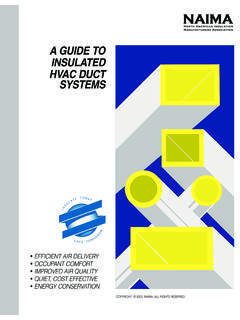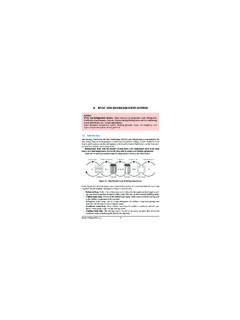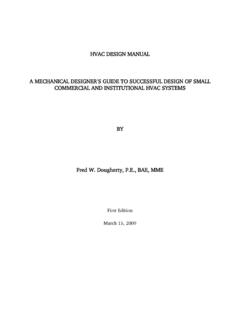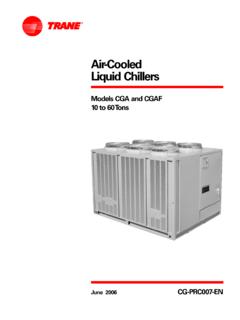Transcription of Sustainable HVAC Systems in Commercial And Residential ...
1 International Journal of Scientific and Research Publications, Volume 4, Issue 4, April 2014 1 ISSN 2250-3153 Sustainable hvac Systems in Commercial And Residential Buildings Arsha Viswambharan*, Sheetal Kumar Patidar** ,Khyati Saxena** * Architecture, MANIT India ** Architecture, MANIT India ** Architecture, MANIT India Abstract- Maintaining optimal temperature and air circulation are the basis of a comfortable indoor environment. This role is played by hvac (Heating, Ventilation and Air conditioning) Systems . All heating, ventilation and air conditioning system account for 60% of the World's total energy consumption this calls for a Sustainable solutions for hvac Systems . We discuss many of such techniques used around the globe in this paper. The main objective is to minimise the energy consumption by shifting towards natural renewable sources while maintaining the required comfort level of a building .
2 Index Terms- hvac , Radiant Systems , Solar AC, Trombe wall. I. introduction A modern building has a numerous requirements. Fresh air, Cooling and heating play an important role in designing and managing a building . An hvac (Heat, Ventilation and Air conditioning) Systems are provided so as to meet the requirements of comfort, cost, efficiency and aesthetic appeal. A Sustainable system adds to the complexity of designing an hvac system . The energy consumption by buildings must be reduced without compromising in the services provided by the building in a Sustainable way, thus ensuring a comfortable indoor climate for the people. The major aspect of setting the energy goals should be hvac system . The most efficient way of lowering the energy consumption is by improving the energy efficiency.
3 The cooling needs in a building are increasing day by day to provide a comfortable indoor environment because of the extreme weather conditions and types. a favourable strategy for Sustainable cooling is by using large surface at relatively high temperatures for radiant cooling system . This can be used for both heating and cooling the surfaces which provides a comfortable ambiance. Radiant cooling Systems can be provided in spaces where the cooling load during day time is higher. Radiant cooling offers optimal operating conditions for integration of renewable energy and free cooling. Basically in a Sustainable hvac system the main focus is on management of waste and pollutants which can extend up to the material of the equipments and the well being of the staff.
4 The installation cost of an hvac system can be attained by 30% cutting down of yearly energy cost and can be regained within a few years when the building gains conventional comfort. By providing natural ventilation and air movements the savings can be improved. II. DESIGNING OF hvac system Displacement ventilation is based on the basic principle of air that it rises upwards after being heated by the machines and people. The rising air is then moved outwards from the exhaust placed at a height. This process requires low energy consumption and provides effective air circulation- which is in term with its sustainability- but it needs an inlet of pre-conditioned air from outside. Combining air distribution Systems with floor access could be an added advantage.
5 Outdoor air pre-heating integrating Systems bank on collaborative solutions, co-ordination to get maximum advantages. A perforated metal plate is used to make a non-languishing Trombe wall which is used to preheat the air from outside or to make an outside wall shaded. Exposure to the southern direction is optimal for this product. It is cost effective as most of the heat produced is reusable using plain gas-fuelled Systems rather than boiler or reheating coils which means lower cost and better performance. Heat pumps: Geothermal heat utilizes the contained heat of earth or water body to enhance the performance a normal heat pump mechanism by narrowing the range of loop temperature. Structure of this field loop and selection of the water body depends upon the site characteristics.
6 Photovoltaic Systems are more cost effective today. The chief cost generates in conversion and in providing connection to its utility grid. Solar thermal Systems are the best forms of renewable energy. Its heat can be useful in industrial as well as domestic needs for hot water and could also be used to hasten the air conditioning plant. Liquid desiccant conditioners and absorbent chillers could be used to abstract latent heat for air supply of a building . Integrated photovoltaic system is composed of roofing materials like metal panels and tiles pr glazing materials like skylights acting like substrates for solar cells it hence ends the need of the usual framing Systems which in turn reduces its cost. Cooling of solar cell puts the cell in order such that it utilizes natural convection of the building or its conditioned relief, reducing the cell s temperature, hence contributing to its conversion efficiency.
7 International Journal of Scientific and Research Publications, Volume 4, Issue 4, April 2014 2 ISSN 2250-3153 A Sustainable method of heating and cooling as well is to use temp of water solution on radiant large surfaces applying high temperature for cooling and low for heating. Less energy is needed when an average temperature is maintained of water (18-28 C) closer to the surroundings comfortable temperature. These Systems are integrated in the building s structure, leaving a smooth facade for the building and flexile interior architecture. III. RADIANT HEATING AND COOLING Systems A radiant system has water channelled pipes interspersed in the floors, walls or ceilings (in the concrete slabs) since more than 60% of energy commutation is by Heating in low temperatures and cooling in high temperatures makes a building energy efficient and makes it a high performance building .
8 The floor and ceiling system can acquire and output of up to 100 W/m and cooling output of 60 W/m and up to 75 W/m cooling can be achieved with comfort panels for suspended ceilings. In case of a radiant heating system that uses low-temperature the performance of energy source will be noticeably more when compared to the usual techniques. This reduces the primary energy consumption. The radiant system is different from a typical hvac system because it heats or cools the surface rather than air. Radiant Systems save a large amount of energy and provides comfort depending on the climate. Spaces like docks and warehouses are suitable for radiant floor heating. This system cannot be used for humidity control, it is best for dry climates.
9 IV. INTEGRATION OF RENEWABLE ENERGY SOURCE Large surfaces can be used as reflectors and it allows cooling and heating at temperatures close to the surroundings. The renewable energy can be combined and utilized with ease. Ground-source heating can be amalgamated into the system via ground heat pumps. Mixing a radiant system with free cooling source can lower down the energy consumption by 90%, since only electricity for circulation pumps is required. Ground water's temperature is apt for Radiant system . This system can be powered by cooling with solar energy or sea water. V. NEED FOR Sustainable COOLING Some proclivities show that the cooling requirements in the whole building mass will elevate in the future. This is caused due to the extreme weather conditions with warmer summers and also due to the increasing comfort needs of people.
10 The building codes should be amended according to the changing needs for the tightness of building envelopes thus introducing convincing cooling demands in summer. It is applicable in offices and industrial buildings. The heating and cooling needs of the building are satisfied with minimum usage of energy via free cooling with a ground-coupled heat pump. Water can be utilized for cooling in the form of cooling panels and beams. the thermo-active constructions are known for their energy performance and cooling effect. It follows a principle of pipes interspersed in the floors, walls or ceilings whereby the building mass is activated. This is best suitable for thermal indoor climate and also the peak load reduces considerably. The cooling is more required in office buildings due to the heat released by people and equipments.
















